
Introduction 
Hi, I'm Rudy Maxa. Picture a landscape so extraordinarily beautiful that it takes even experienced travelers by surprise. A place where you can scale mountains in the morning, sea kayak in the afternoon and still savor a gourmet meal at night. Next up, it's New Zealand's North Island on Smart Travels.
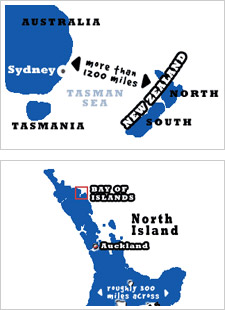 The Polynesian people named it the "Land of the Long White Cloud"...a spectacular country molded by cataclysmic events and veiled in mystery. For centuries, New Zealand was completely isolated from other landmasses. It evolved plant and animal species found nowhere else on earth. It's a place that inspires reverence in natives and visitors alike—a reverence for the land and this country's ancient roots.
The Polynesian people named it the "Land of the Long White Cloud"...a spectacular country molded by cataclysmic events and veiled in mystery. For centuries, New Zealand was completely isolated from other landmasses. It evolved plant and animal species found nowhere else on earth. It's a place that inspires reverence in natives and visitors alike—a reverence for the land and this country's ancient roots.
It's hard to believe that so much scenic loveliness can be concentrated into such a small country. New Zealand is about the size of Britain, yet it has an amazingly diverse climate that ranges from glacial to temperate to tropical. This trip we're veering off the tourist track into the rural reaches of New Zealand's North Island.
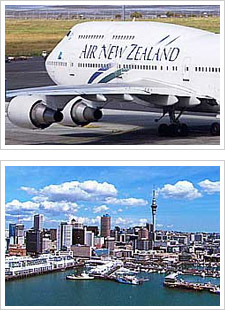 New Zealand in located in the southern Pacific more than 1200 miles from the mainland of Australia. After landing in Auckland, we'll head to the breathtaking Bay of Islands, and the towns of Paihia and Russell. Then we'll travel south to the pasturelands of Hawke's Bay.
New Zealand in located in the southern Pacific more than 1200 miles from the mainland of Australia. After landing in Auckland, we'll head to the breathtaking Bay of Islands, and the towns of Paihia and Russell. Then we'll travel south to the pasturelands of Hawke's Bay.
Most travelers to New Zealand arrive by air, landing here at Auckland's international airport. Our flight from North America took about 12 hours. But it was worth it!
New Zealanders, nicknamed "Kiwis", are proud of Auckland, their biggest city. It's green, clean and sophisticated. But I haven't come to New Zealand for city sights. I'm off in search of this country's best scenic beauty.
We're traveling to the Northland, a  part of New Zealand that's rich in Maori and European history. We arrive in Paihia, a scenic tourist town and gateway to the area known as the Bay of Islands. Some of the county's most glorious coastline can be found right here. This maritime area encompasses more than 140 Islands abundant with fish and wildlife.
part of New Zealand that's rich in Maori and European history. We arrive in Paihia, a scenic tourist town and gateway to the area known as the Bay of Islands. Some of the county's most glorious coastline can be found right here. This maritime area encompasses more than 140 Islands abundant with fish and wildlife.
Kayaking Trip 
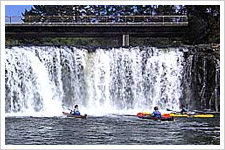 First on my list of activities is a kayaking trip. There's no better way to enjoy the Bay of Islands sub-tropical coastline than by sea kayak. It was in the northern part of the country that New Zealand's earliest settlers first landed. Eastern Polynesian immigrants, whose descendants are known as the Maori, arrived here about 1000 years ago.
First on my list of activities is a kayaking trip. There's no better way to enjoy the Bay of Islands sub-tropical coastline than by sea kayak. It was in the northern part of the country that New Zealand's earliest settlers first landed. Eastern Polynesian immigrants, whose descendants are known as the Maori, arrived here about 1000 years ago.
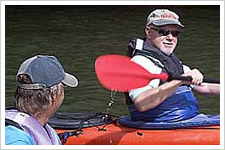 It's impossible not to linger at the spectacular Haruru Falls. Haruru means "big noise" and the water here cascades over the cliff in an unusual horseshoe shape. According to Maori legend, a water monster lives in the lagoon below the falls.
It's impossible not to linger at the spectacular Haruru Falls. Haruru means "big noise" and the water here cascades over the cliff in an unusual horseshoe shape. According to Maori legend, a water monster lives in the lagoon below the falls.
Many species of flightless birds once thrived in New Zealand because they had no natural predators. The Maori made the most of this easy prey and hunted several bird species to near extinction. The islanders then turned to fishing and agriculture.
A Dutch explorer named Abel Tasman was the first European to arrive in New Zealand. But it wasn't until the legendary Brit, Captain James Cook, landed in the North Island in 1769 that Europeans began coming in droves. Whalers, traders, missionaries—they descending on the islands. New Zealand became a colony of the British Empire in 1840.
Waitangi Treaty Grounds 
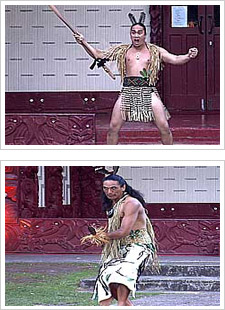 We're stopping by New Zealand's most historic site. The Waitangi Treaty Grounds are often referred to as the "Birthplace of the Nation."
We're stopping by New Zealand's most historic site. The Waitangi Treaty Grounds are often referred to as the "Birthplace of the Nation."
It was here that a famous treaty was signed between Maori chiefs and Britain. The explosion of European immigration to New Zealand meant that some kind of policy was needed for land deals. With the Treaty of Waitangi, the Maori chiefs accepted British presence in exchange for protection and guaranteed ownership of their land.
But because of language differences, the Maori almost certainly didn't understand the treaty's fine print, which gave great advantage to the Brits. Fighting quickly broke out between the natives and the new settlers. To this day, the treaty has been blamed for unrest between Maori and Pakeha (the name given to Europeans settlers and their descendants). These grounds are considered a spiritual site by the Maori people, and certain protocols must be observed when visiting here. This challenge ceremony was traditionally performed to determine whether or not visitors came in peace.
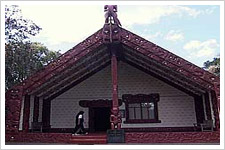 You can explore the Treaty grounds by yourself or take a guided tour departing daily from the Visitors Center.
You can explore the Treaty grounds by yourself or take a guided tour departing daily from the Visitors Center.
The Meeting House contains carvings that trace the genealogy of different tribes, and holds important symbols from Maori culture.
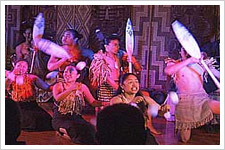 In the evening, a live show about Maori history takes place in the Meeting House The story begins with the great migration: a long ocean journey from eastern Polynesia to New Zealand. The islanders bring with them a rich culture which, over time and in isolation, becomes uniquely Maori. Frequent intertribal warfare punctuates daily life. Eventually the ancient Maori traditions collide with European settlement.
In the evening, a live show about Maori history takes place in the Meeting House The story begins with the great migration: a long ocean journey from eastern Polynesia to New Zealand. The islanders bring with them a rich culture which, over time and in isolation, becomes uniquely Maori. Frequent intertribal warfare punctuates daily life. Eventually the ancient Maori traditions collide with European settlement.
Today, the Maori people still represent about a third of the population here in the Northland.
TIP
For show information: www.culturenorth.co.nz.
Russel 
A little car ferry at the port of Opua will take us across the water to Russell. It's obvious that this is boater's paradise—the bay is filled with motorboats, sailboats, and yachts of every description.
With its charming waterfront walkway and timber houses, the town of Russell is a pleasure to stroll. It's hard to believe that this was once known as "the hell hole of the Pacific".
It started out as a quiet Maori village, but as Europeans began pouring into the North Island, Russell evolved into a lawless frontier town. Rife with ship deserters and ex-convicts, it became infamous for prostitution, gun fights and street brawls.
Russell's reputation might have been played up a bit by local missionaries hoping to get a little extra support from Mother England. But the town certainly included some unsavory characters. An early British surveyor reported that this was 'a vile hole, full of impudent, half-drunken people'. These days, though, it's an attractive fishing town with a tempting selection of restaurants, shops and galleries. It makes a good base for exploring the area.
Kauri Forest 
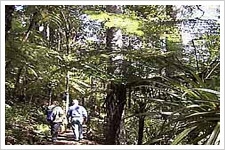 A short drive takes us away from town to the primeval majesty of a kauri forest. The kauri is the largest species of tree in New Zealand. At one time, these giant trees covered the island. The size and strength of kauri timber made it a popular wood for construction and shipbuilding, particularly for masts of sailing ships.
A short drive takes us away from town to the primeval majesty of a kauri forest. The kauri is the largest species of tree in New Zealand. At one time, these giant trees covered the island. The size and strength of kauri timber made it a popular wood for construction and shipbuilding, particularly for masts of sailing ships.
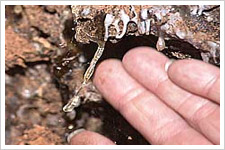 Until the 1940's, a profitable industry that exploited kauri gum severely damaged the trees here. New Zealand's forests are still trying to recover.
Until the 1940's, a profitable industry that exploited kauri gum severely damaged the trees here. New Zealand's forests are still trying to recover.
The flora of New Zealand has a distinctive look because it evolved in isolation for millions of years. More than three-quarters of the native plants and trees grow here and nowhere else.
Chelwood Oyster Farm 
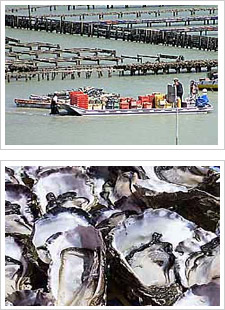 New Zealand is heavily dependent on farming and horticulture, and tempts visitors with a range of gourmet delicacies. The Bay of Islands in particular is known as a top oyster farming location.
New Zealand is heavily dependent on farming and horticulture, and tempts visitors with a range of gourmet delicacies. The Bay of Islands in particular is known as a top oyster farming location.
And as a devoted mollusk fan, I can't wait to get my fill! Here at Chelwood Oyster Farm, we learned a bit about how oysters are grown and harvested. Orongo Bay oysters are recognized as top class and are exported around the world.
Orongo Bay Homestead 
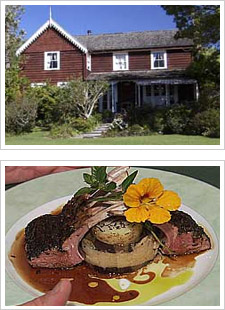 We'll have our oysters served up in style at the Orongo Bay Homestead. Enjoying a commanding view over grand lawns and bay waters, this historic residence was built in the 1860s for the first American Consular Agent in New Zealand.
We'll have our oysters served up in style at the Orongo Bay Homestead. Enjoying a commanding view over grand lawns and bay waters, this historic residence was built in the 1860s for the first American Consular Agent in New Zealand.
Now the restored Homestead is an exclusive country inn offering fine wine and renowned cuisine.
Many kiwis are embracing a movement toward organic food and green living, and the herbs and garnishes served here are grown right on the property.
Voyage To Cape Brett Lighthouse 
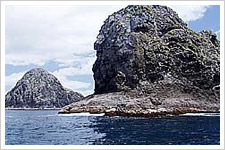 To work off all that food, a day trip to the Cape Brett Lighthouse is just the thing. For those who like a challenge, you can make the journey on foot, an invigorating 8 hour hike. Or you can take an easier route (like us), and make part of the trip by water.
To work off all that food, a day trip to the Cape Brett Lighthouse is just the thing. For those who like a challenge, you can make the journey on foot, an invigorating 8 hour hike. Or you can take an easier route (like us), and make part of the trip by water.
We climb aboard Kiwi EcoTours for the voyage to Cape Brett. Our guide welcomes us with a traditional Maori prayer.
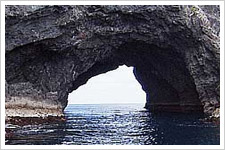 This rugged stretch of coastline is situated at the entrance to the Bay of Islands. The seven distinctive peaks that mark the peninsula's spine are said to represent the seven canoes that carried the Maori settlers on their great migration to New Zealand. A place of wild beauty, the coastline is sculpted with dramatic rock formations, including the famous "Hole in the rock". Nearby "Cathedral Cave" lives up to its name with a grand interior and colorful rock walls.
This rugged stretch of coastline is situated at the entrance to the Bay of Islands. The seven distinctive peaks that mark the peninsula's spine are said to represent the seven canoes that carried the Maori settlers on their great migration to New Zealand. A place of wild beauty, the coastline is sculpted with dramatic rock formations, including the famous "Hole in the rock". Nearby "Cathedral Cave" lives up to its name with a grand interior and colorful rock walls.
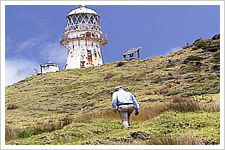 A short but steep hike takes you to the Cape Brett lighthouse. When British Captain James Cook first arrived here, he christened the spot in honor of a lord of the admiralty, Sir Piercy Brett.
A short but steep hike takes you to the Cape Brett lighthouse. When British Captain James Cook first arrived here, he christened the spot in honor of a lord of the admiralty, Sir Piercy Brett.
Later, it was the site of one of New Zealand's early shipwrecks. A British crew contracted with local Maori to load a schooner. The crew then double-crossed the Maori, throwing them overboard. But the sailors got their comeuppance. The ship encountered bad weather, and those who didn't drown were killed by the Maori.
The Bay of Islands is so gorgeous and relaxing, I could stay forever. But, as they say here in New Zealand, I better rattle my dags. It's time to get moving to our next destination.
Hawke's Bay 
 We're off to Hawke's Bay, located on the central east coast of the North Island.
We're off to Hawke's Bay, located on the central east coast of the North Island.
This area is fondly known as the "Fruit bowl of New Zealand". It rolls out a royal carpet of pastureland, orchards and vineyards. Acres upon acres of park-like farmland are rimmed by dramatic sea cliffs and coastal bays. The area's known for its Mediterranean-like climate; sunny, dry and ideal for vacation getaways.
Napier 
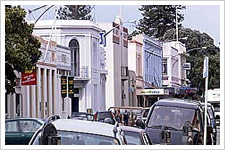 Sitting handsomely on the bay, the town of Napier is a blast from the Art Deco past. Back in 1931, a horrific earthquake devastated this city, destroying most of the buildings.
Sitting handsomely on the bay, the town of Napier is a blast from the Art Deco past. Back in 1931, a horrific earthquake devastated this city, destroying most of the buildings.
So what did the people here do? Picked themselves up, brushed themselves off and set about rebuilding. In style.
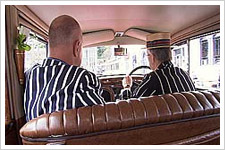 As it happened, Art Deco architecture was the fashion of the day. Local Art Deco expert and all-around character "Bertie" is wealth of information about Napier.
As it happened, Art Deco architecture was the fashion of the day. Local Art Deco expert and all-around character "Bertie" is wealth of information about Napier.
Art Deco's future-looking style appealed to the idealism and escapism of the 1930's depression era.
Greenhill The Lodge 
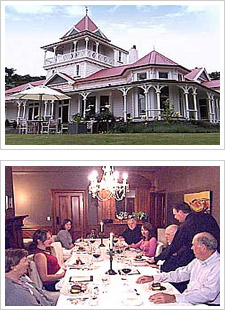 New Zealand is famous for its many luxury lodges, offering tranquil retreats in wilderness settings. Greenhill the Lodge, dating to the late 19th century, is a good example. About a half-hour outside Napier, Greenhill features panoramic views of the surrounding countryside. The lodge's moment of fame came in 1958 when Queen Elizabeth the Queen Mother stayed here at the homestead. While touring the country, she wanted a few days rest and asked to stay in a home "typical of early pioneering days".
New Zealand is famous for its many luxury lodges, offering tranquil retreats in wilderness settings. Greenhill the Lodge, dating to the late 19th century, is a good example. About a half-hour outside Napier, Greenhill features panoramic views of the surrounding countryside. The lodge's moment of fame came in 1958 when Queen Elizabeth the Queen Mother stayed here at the homestead. While touring the country, she wanted a few days rest and asked to stay in a home "typical of early pioneering days".
On Yer Bike Winery Tours 
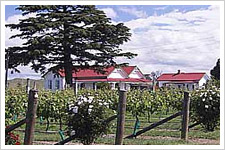 This is wine country. And I think the best way to tour the area's many vineyards is by bicycle. You can spend the day sampling some the Hawke Bay's finest food and wines, all while getting an upclose look at olive groves, ostrich farms and country inns.
This is wine country. And I think the best way to tour the area's many vineyards is by bicycle. You can spend the day sampling some the Hawke Bay's finest food and wines, all while getting an upclose look at olive groves, ostrich farms and country inns.
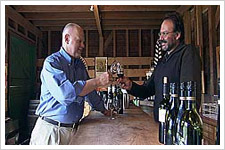 For help with a self-guided tour, "On Yer Bike Winery Tours" offers three routes catering to all fitness levels. You can visit up to six different wineries using the maps provided.
For help with a self-guided tour, "On Yer Bike Winery Tours" offers three routes catering to all fitness levels. You can visit up to six different wineries using the maps provided.
Ngatarawa Winery 
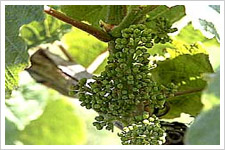 We're stopping at the Ngatarawa winery to sample the area's famous chardonnay.
We're stopping at the Ngatarawa winery to sample the area's famous chardonnay.
With its warm weather and gravelly soil, the area's been dubbed the 'Tuscany of the South Pacific'.
TIP
For a copy of the Hawke's Bay Regional Winery Guide, visit www.hawkesbaynz.com.
Food Trail 
 If you're not into wine, another fun activity is the self-guided Food Trail. Armed with this local map, you can visit various producers in the region. The popular trail leads to dozens fresh, local specialties.
If you're not into wine, another fun activity is the self-guided Food Trail. Armed with this local map, you can visit various producers in the region. The popular trail leads to dozens fresh, local specialties.
Each food trail destination is well-marked at the gate or entranceway, with a corresponding number on the food trail map.
At Arataki honey we found some very busy bees and lots of sweet stuff to sample...next stop, strawberry fields that go on forever...Te Mata Cheese lures us with an array of artisan cheeses...and then there's my personal favorite: homemade ice cream!
 Wherever vineyards thrive, olives do just as well.
Wherever vineyards thrive, olives do just as well.
The Village Press uses old-style methods to extract for maximum taste and purity.
TIP
Food Trail information is available from Tourism New Zealand and www.savourhawkesbay.co.nz.
Cape Kidnappers 
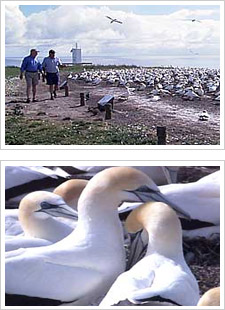 One of the most dramatic sights on Hawke's Bay is Cape Kidnappers. It's home to a massive colony of gannet birds. This coastal preserve can be reached overland by four-wheel drive or by hiking along the beach (tide permitting). These birds usually nest on inaccessible islands, so this is a rare opportunity to get an up-close look. Gannets perform elaborate greeting rituals, stretching their necks upwards and tapping bills together. The birds are superb fishers plunging into the ocean full speed ahead. At about 15 weeks of age, the young gannets make a harrowing flight to Australia. They stay there for three to five years and then return here to New Zealand to nest.
One of the most dramatic sights on Hawke's Bay is Cape Kidnappers. It's home to a massive colony of gannet birds. This coastal preserve can be reached overland by four-wheel drive or by hiking along the beach (tide permitting). These birds usually nest on inaccessible islands, so this is a rare opportunity to get an up-close look. Gannets perform elaborate greeting rituals, stretching their necks upwards and tapping bills together. The birds are superb fishers plunging into the ocean full speed ahead. At about 15 weeks of age, the young gannets make a harrowing flight to Australia. They stay there for three to five years and then return here to New Zealand to nest.
Cheerio! 
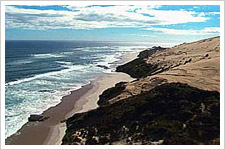 New Zealand's ecological diversity and unique beauty give it an almost ethereal quality. To the Maori it continues to be the "Land of the Long White Cloud". To adventure seekers, it's a travel dream come true.
New Zealand's ecological diversity and unique beauty give it an almost ethereal quality. To the Maori it continues to be the "Land of the Long White Cloud". To adventure seekers, it's a travel dream come true.
From the land of the Kiwis, I'm Rudy Maxa wishing you a fond cheerio!

Interested in planning your vacation Down Under?
Start your trip at
Expedia.com/NewZealand.
Links
For a copy of the Hawke's Bay Regional Winery Guide, visit www.hawkesbaynz.com.
Food Trail information is available from Tourism New Zealand and www.savourhawkesbay.co.nz.
